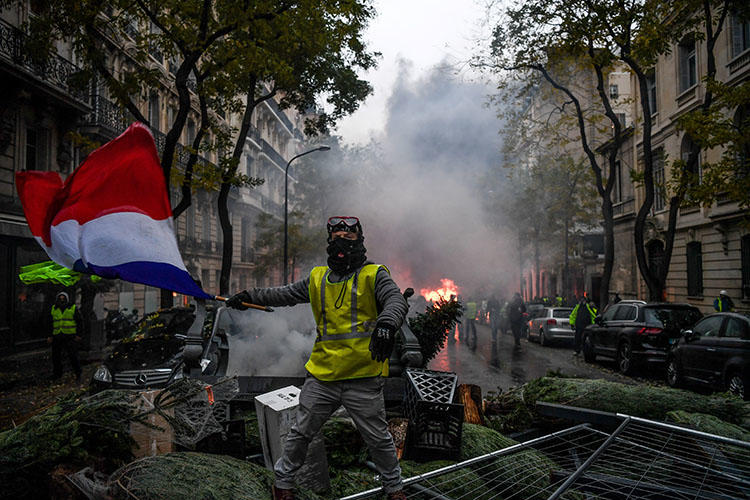Despite the French government announcing it will drop a proposed fuel tax rise, the gilets jaunes (yellow jackets) group, truckers, and farming groups have called for more protests, according to The Guardian. Mass demonstrations have taken place across France and Belgium as initial protests over the proposed increase in fuel duty on diesel spread to wider disaffection over the cost of living. At least three people have been killed and hundreds have been injured since protests began in mid-November, according to reports.
While the majority of protesters are peaceful, police and agitators allegedly from the far right and anarchist left have clashed and there are reports of looting, according to the BBC. Some protesters attacked police with paving stones and other missiles, and police have used teargas, pepper spray and water cannon.
Journalists have been attacked and harassed while covering the protests, and reporters covering the unrest in France told CPJ they expect more violence. The Council of Europe’s platform to promote the protection of journalism and the safety of journalists listed several incidents from the French protest, including accounts of journalists being harassed with racist insults, protesters attacking television reporters in Montpellier, attempting to break into a news room of the newspaper Midi Libre, and reporters being attacked or threatened. In one case, a group of journalists from BFM TV and CNews teams escaped what the COE described as an attempted lynching. The Council of Europe reported that police in Brussels violently detained a journalist filming the clashes.
A journalist covering events in Paris, who spoke with CPJ on condition of anonymity, said that the majority of protestors are non-threatening but when the police started cracking down, the tension increased. Crush injuries were a concern because it was easy to fall and be injured when crowds fled advancing water cannon.
Journalists can minimize the risk by following CPJ’s guidance below.
Be prepared:
- Plan the assignment and ensure that you have a full battery on your cell phone. Know the area you are going to. Work out in advance what to do in an emergency.
- Always try to work with a colleague and have a regular check-in procedure with your base–particularly if covering rallies or crowded events.
- Wear clothing and footwear that allow you to move swiftly. Avoid wearing necklaces, ponytails, lanyards or anything that can be grabbed, as well as flammable material, such as nylon.
- Consider your position. Try to find an elevated position that may offer greater safety.
- At any location, always plan an evacuation route. If working with others, select an emergency rendezvous point.
- Maintain situational awareness at all times and limit valuables in your possession. Do not leave any equipment in vehicles. After dark, the risk of criminal actions increases.
- If working in a crowd, plan a strategy. Try to keep to the outside of the crowd and avoid the middle, where it is hard to escape. Identify an escape route.
In situations where teargas may be used:
- Wear personal protective equipment, including a gas mask, eye protection, body armor, and helmet.
- Contact lenses are not advisable.
- Individuals with asthma or respiratory issues should avoid areas where teargas is being used. When large amounts of teargas are used, there is the possibility of high concentrations of gas sitting in areas with no movement of air.
- Take note of landmarks (i.e. posts, curbs) that can be used to help you navigate out of an area if you are struggling to see.
- If you are exposed to teargas, try to find higher ground and stand in fresh air to allow the breeze to carry away the gas. Do not rub your eyes or face. When you are able to, shower in cold water to wash the gas from your skin, but do not bathe. Clothing may need to be washed several times to remove the crystals completely, or discarded.
When dealing with aggression:
- Read body language and use your own body language to pacify a situation.
- Keep eye contact with an aggressor, use open hand gestures and keep talking with a calming manner.
- Keep an extended arm’s length from the threat. Back away and if someone grabs hold of you, break away firmly without aggression. If cornered and in danger, shout.
- If the situation escalates, keep a hand free to protect your head and move with short, deliberate steps to avoid falling. If in a team, stick together and link arms.
- Be aware of the situation and your own safety. While there are times when documenting aggression can be newsworthy, taking pictures of aggressive individuals can escalate a situation.
Journalists requiring assistance can contact CPJ via [email protected].
CPJ’s Journalist Security Guide has additional information on basic preparedness, assessing and responding to risk, or safety measures when covering civil conflict and disturbances. CPJ’s resource center has additional information and tools for pre-assignment preparation and post-incident assistance.
